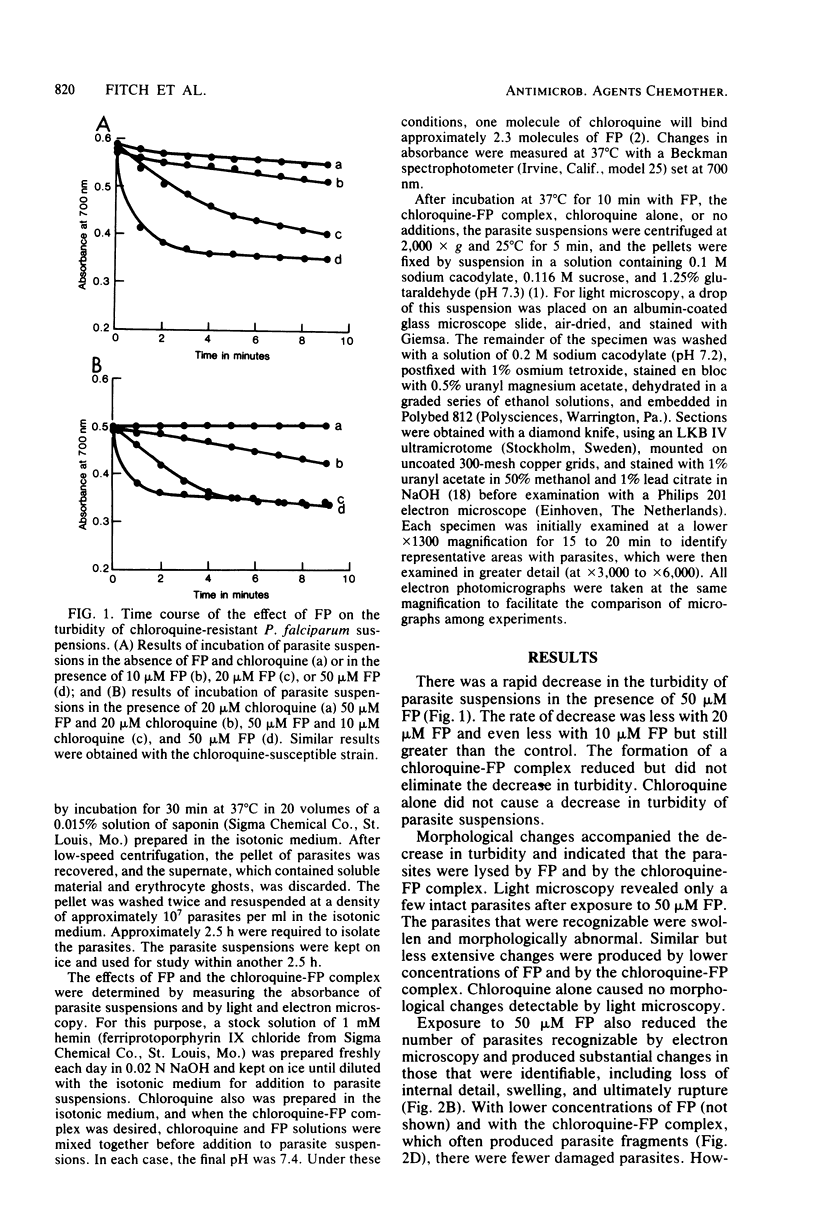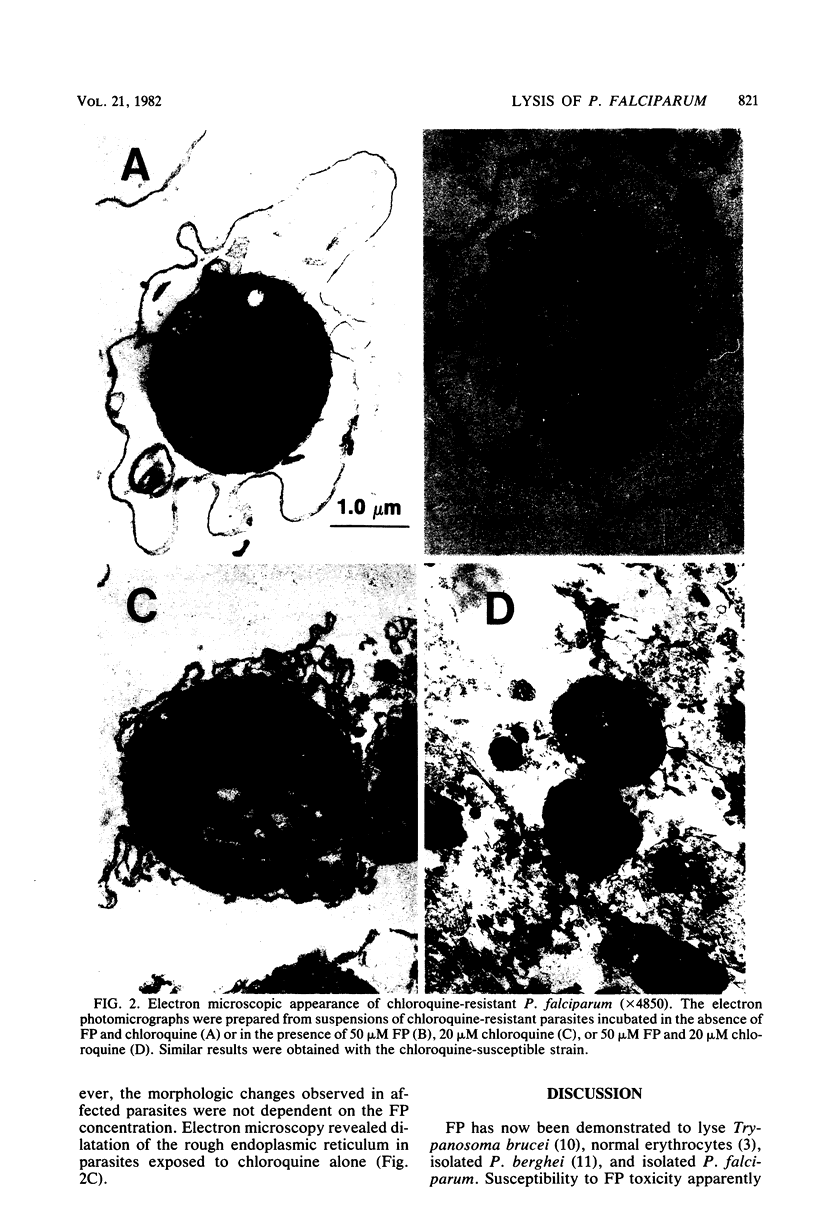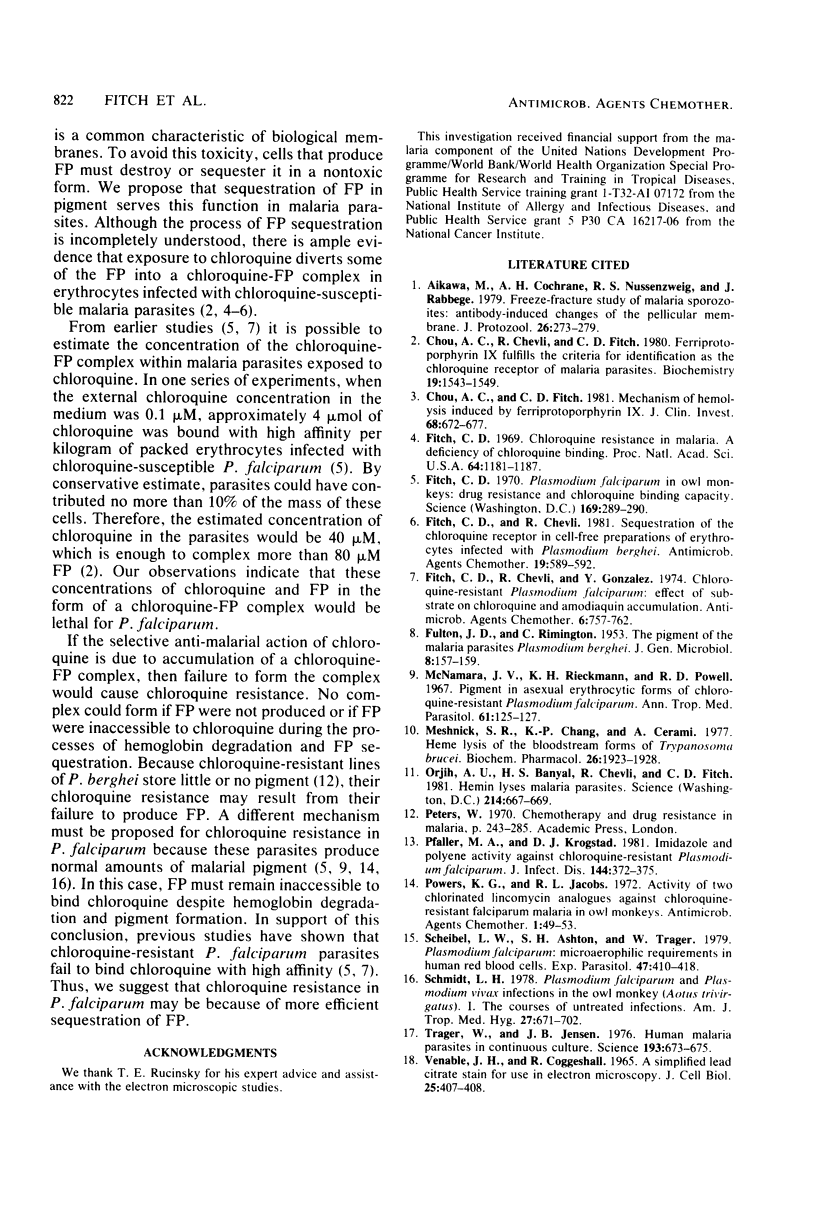Abstract
Ferriprotoporphyrin IX (FP) and a chloroquine-FP complex lysed isolated Plasmodium falciparum parasites as judged by decreases in the turbidity of parasite suspensions and by ultrastructural changes. Exposure of parasite suspensions to 50 microM FP or to a complex formed from 50 microM FP and 20 MicroM chloroquine reduced the number of identifiable parasites and caused swelling and loss of internal detail in those that were identifiable. The amount of lysis was dose-dependent over the range of 10 to 50 microM FP. Formation of a chloroquine-FP complex reduced, but did not eliminate, the toxicity of FP. Since there is evidence indicating that a chloroquine-FP complex forms when chloroquine-susceptible parasites are exposed to chloroquine, we suggest that accumulation of this complex may account for the chemotherapeutic effect of chloroquine against P. falciparum.
Full text
PDF



Images in this article
Selected References
These references are in PubMed. This may not be the complete list of references from this article.
- Aikawa M., Cochrane A. H., Nussenzweig R. S., Rabbege J. Freeze-fracture study of malaria sporozoites: antibody-induced changes of the pellicular membrane. J Protozool. 1979 May;26(2):273–279. doi: 10.1111/j.1550-7408.1979.tb02779.x. [DOI] [PubMed] [Google Scholar]
- Chou A. C., Chevli R., Fitch C. D. Ferriprotoporphyrin IX fulfills the criteria for identification as the chloroquine receptor of malaria parasites. Biochemistry. 1980 Apr 15;19(8):1543–1549. doi: 10.1021/bi00549a600. [DOI] [PubMed] [Google Scholar]
- Chou A. C., Fitch C. D. Mechanism of hemolysis induced by ferriprotoporphyrin IX. J Clin Invest. 1981 Sep;68(3):672–677. doi: 10.1172/JCI110302. [DOI] [PMC free article] [PubMed] [Google Scholar]
- FULTON J. D., RIMINGTON C. The pigment of the malaria parasite Plasmodium berghei. J Gen Microbiol. 1953 Feb;8(1):157–159. doi: 10.1099/00221287-8-1-157. [DOI] [PubMed] [Google Scholar]
- Fitch C. D., Chevli R., Gonzalez Y. Chloroquine-resistant Plasmodium falciparum: effect of substrate on chloroquine and amodiaquin accumulation. Antimicrob Agents Chemother. 1974 Dec;6(6):757–762. doi: 10.1128/aac.6.6.757. [DOI] [PMC free article] [PubMed] [Google Scholar]
- Fitch C. D., Chevli R. Sequestration of the chloroquine receptor in cell-free preparations of erythrocytes infected with Plasmodium berghei. Antimicrob Agents Chemother. 1981 Apr;19(4):589–592. doi: 10.1128/aac.19.4.589. [DOI] [PMC free article] [PubMed] [Google Scholar]
- Fitch C. D. Chloroquine resistance in malaria: a deficiency of chloroquine binding. Proc Natl Acad Sci U S A. 1969 Dec;64(4):1181–1187. doi: 10.1073/pnas.64.4.1181. [DOI] [PMC free article] [PubMed] [Google Scholar]
- Fitch C. D. Plasmodium falciparum in owl monkeys: drug resistance and chloroquine binding capacity. Science. 1970 Jul 17;169(3942):289–290. doi: 10.1126/science.169.3942.289. [DOI] [PubMed] [Google Scholar]
- McNamara J. V., Rieckmann K. H., Powell R. D. Pigment in asexual erythrocytic forms of chloroquine-resistant Plasmodium falciparum. Ann Trop Med Parasitol. 1967 Jun;61(2):125–127. doi: 10.1080/00034983.1967.11686468. [DOI] [PubMed] [Google Scholar]
- Meshnick S. R., Chang K. P., Cerami A. Heme lysis of the bloodstream forms of Trypanosoma brucei. Biochem Pharmacol. 1977 Oct 15;26(20):1923–1928. doi: 10.1016/0006-2952(77)90167-8. [DOI] [PubMed] [Google Scholar]
- Orjih A. U., Banyal H. S., Chevli R., Fitch C. D. Hemin lyses malaria parasites. Science. 1981 Nov 6;214(4521):667–669. doi: 10.1126/science.7027441. [DOI] [PubMed] [Google Scholar]
- Pfaller M. A., Krogstad D. J. Imidazole and polyene activity against chloroquine-resistant Plasmodium falciparum. J Infect Dis. 1981 Oct;144(4):372–375. doi: 10.1093/infdis/144.4.372. [DOI] [PubMed] [Google Scholar]
- Powers K. G., Jacobs R. L. Activity of two chlorinated lincomycin analogues against chloroquine-resistant falciparum malaria in owl monkeys. Antimicrob Agents Chemother. 1972 Jan;1(1):49–53. doi: 10.1128/aac.1.1.49. [DOI] [PMC free article] [PubMed] [Google Scholar]
- Scheibel L. W., Ashton S. H., Trager W. Plasmodium falciparum: microaerophilic requirements in human red blood cells. Exp Parasitol. 1979 Jun;47(3):410–418. doi: 10.1016/0014-4894(79)90094-8. [DOI] [PubMed] [Google Scholar]
- Schmidt L. H. Plasmodium falciparum and Plasmodium vivax infections in the owl monkey (Aotus trivirgatus). I. The courses of untreated infections. Am J Trop Med Hyg. 1978 Jul;27(4):671–702. doi: 10.4269/ajtmh.1978.27.671. [DOI] [PubMed] [Google Scholar]
- Trager W., Jensen J. B. Human malaria parasites in continuous culture. Science. 1976 Aug 20;193(4254):673–675. doi: 10.1126/science.781840. [DOI] [PubMed] [Google Scholar]
- VENABLE J. H., COGGESHALL R. A SIMPLIFIED LEAD CITRATE STAIN FOR USE IN ELECTRON MICROSCOPY. J Cell Biol. 1965 May;25:407–408. doi: 10.1083/jcb.25.2.407. [DOI] [PMC free article] [PubMed] [Google Scholar]



